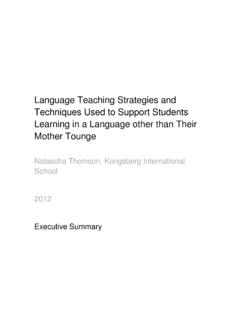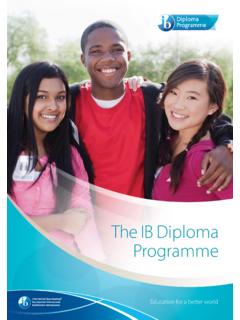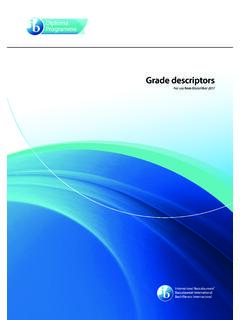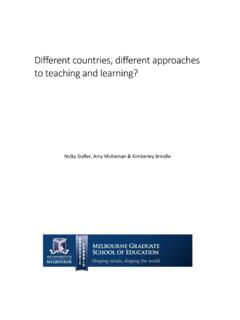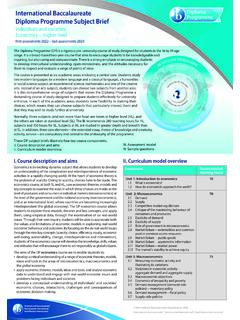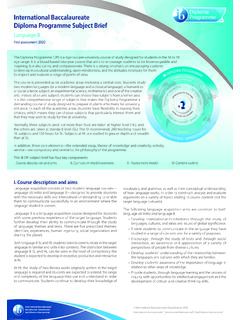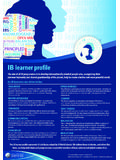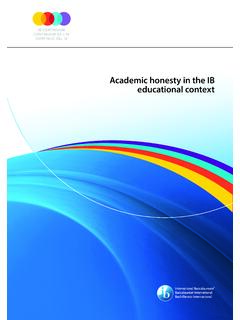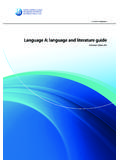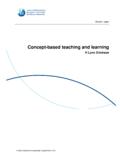Transcription of APPROACHES TO LEARNIN - International Baccalaureate
1 International Baccalaureate Organization 2020 International Baccalaureate | Baccalaur at International | Bachillerato Internacional APPROACHESTO LEARNINGA pproaches to learning (ATL) are skills designed to enable students in the IB Middle Years Programme (MYP) to learn how to learn. They are intended to apply across curriculum requirements and provide a common language for teachers and students to use when reflecting and building on the process of learning . IB World Schools are required to ensure there is an ATL planning chart for all years of the MYP. However, broader implementation would see ATLs implicitly and explicitly embedded into day-to-day learning experiences, so that students have opportunities to practice and incrementally develop a range of ATL report summarizes the findings from the research study by the Claremont Evaluation Centre (CEC) on implementation of ATL as part of the collaborative does MYP ATLs implementation look like across the world?
2 Findings from teacher surveys (2017, 2018) Many teachers view the ATLs as important and strive to implement them in their classroom. That being said, some find the ATLs difficult to implement and do not believe that explicitly stating them is beneficial for students. Teachers report that some foundational ATL requirements ( creating an ATL chart for all years of the programme) often do not occur. Many activities that require collaboration or preparation outside the classroom often do not occur either. Teachers do report that practices that empower students to take charge as decisionmakers and problem solvers are regularly incorporated into practices findings from 2018 schools visits (27 schools)The main factor that allows for progression in the implementation of ATLs is whether they are explicitly integrated in class activities or first group of schools was exemplified by teachers who consistently included ATLs in their unit planners, yet did not embed them into in-class activities.
3 In this case, teachers frequently expressed that they did not understand how to teach ATL skills effectively. In many cases, implementing ATL skills became a tick-box- in-ManageBac exercise. ATL skills were mainly discussed at the beginning or the end of a class during unit reflections. As such, students in these classes received limited opportunities to practice these skills during class. The following quotation from a student s interview exemplifies the unclarity about the purpose of the skill, and the disconnection between the mention of the skill in class and student s own the beginning of the unit, [the teacher] tells us that [they] expects us to develop this skill by doing the project, things like that. And also, almost all the reflections that the teacher asks us to do, they ask us to write what skills we developed but I do not like to write those skills because I never finish understanding, well, how do I know if I developed exactly that skill - MYP studentIn the second group of schools, teachers clearly considered ATL skills when developing unit planners; they also intentionally provided opportunities for students to practice, develop and reflect upon these skills through class activities and projects.
4 However, teachers in this category rarely referred to the chosen ATL skill throughout the unit or explicitly stated how they were connected to class activities. Further, even if the skills were mentioned at the unit start and conclusion, or were displayed in the classroom, they were not always presented in a way that students could clearly connect them to their own skill development. Teachers noted that the explicit discussion of these skills was still a challenge. However, there was considerable variability between teachers who deliberately embedded the skills into their lesson plans and those who merely mentioned them at the start of the unit and again during reflections. A student reported that:It s mostly if a teacher finds that we re not exactly doing the best that we can, they will just bring out like a certain word, but they ll never really relate it to ATL skills, because even though we don t really talk about it.
5 Because of what we learn and the way we work, we re able to just use all of these skills without realizing it, so I think that s why we don t really need to talk about it MYP StudentIn the third group of schools, teachers (1) clearly embedded ATLs into their unit planners, (2) explicitly reflected upon them with students throughout lesson activities / projects, and (3) provided intentional opportunities for students to practice them. At a handful of schools with more developed planning and collaboration processes, teachers described how they worked to embed ATLs skills, not only in their current units, but vertically across required by MYP, the number of schools that engaged in this cross-year planning of ATLs was , for the sequence we have the overview for units, and just like we plan backwards, I plan backwards the ATL as I think about it and I say: okay, these kids are moving on to the Diploma Programme (DP), so what do they need to have?
6 And specifically, for my subject, so I ask my head of department who also teaches the DP, and what do you feel they need? What s missing? So, a lot of them they say, sometimes it s the research skills, citation of stuff, other times she tells me to please focus on body language or something, so that s communication, that s social, so yes we have a mapping for an overview of the ATL skills. - MYP Teacher SUPPORTto the implementation of APPROACHES to learning BARRIERSto the implementation of APPROACHES to learningEarly adopters of MYP: Next chapter reported higher more positive attitudes about the APPROACHES to learning strategy. They also implemented it in the classroom more use of planning software facilitated the coordination and planning associated with appropriately embedding ATL skills into unit supports mentioned by individual sites were: feedback from previous evaluations, having a designated ATL coordinator, having access to written ATL materials, and ATL specific professional development site administrators expressed frustration that teachers saw teaching ATL skills simply as an IB requirement, and one they did not feel compelled to comply at schools where there were challenges around ATL understanding also struggled to identify the appropriate skills and number of skills to embed in the level of resources and a private only were these sites unable to apply formal accountability mechanisms, teachers also said they lacked the support and understanding to teach ATL skills effectively.
7 This expressed limited teacher understanding was consistent with survey findings, in which 30% of schools did not have fully developed ATL charts for all years of the programme, and in which 29% of teachers were not yet meeting expectations with respect to teacher understanding was the most commonly referenced support for the quality of ATL skill , science and physical and health education teachers found it more difficult than other subjects to implement APPROACHES to learning strategies can schools establish to support teacher planning of ATLs?How can schools find opportunities to embed ATLs into out-of-class activities?Summary The majority of teachers are embedding ATL skills into unit planners and creating opportunities for students to practice them. However, survey findings and classroom observations suggest teachers often do not make explicit reference to these ATL skills. In contrast to last year, we observed fewer instances of ATLs being implicitly or explicitly embedded into class activities and more instances of ATL skills only being used when developing unit planners.
8 Further, despite reported instances of student reflections following the completion of service or personal projects, we did not observe instances where ATLs were embedded into out-of-class activities. Survey findings and site visits also indicate that a small percentage of teachers have not yet bought into teaching ATL skills. Reasons for this limited support include a lack of teacher understanding of how to teach ATLs and administrative support ( limited guidance and opportunities for teacher planning). However, a majority of teachers viewed ATLs as important and strive to implement them. A significant number of schools do not have a written ATL chart for all years of the programme. BackgroundIn mid-2015, the IB commissioned the Claremont Evaluation Center (CEC) to lead a multi-year research project on the MYP: Next chapter s implementation and impact. The CEC study provides a wealth of data about what the implementation of the MYP curriculum looks like around the world in critical curriculum on this multi-year research, the IB has identified three themes that categorize nine high-quality implementation strategies for the MYP: Collaborative strategies Key strategies Optional strategiesThe IB will disseminate the CEC research findings in form of reports for high-quality implementation strategies and many other resources to support schools in further implementing the MYP out more.
